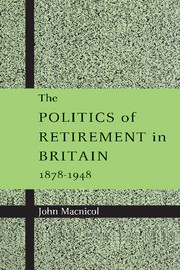Book contents
- Frontmatter
- Contents
- List of tables
- Acknowledgements
- Part I The campaign for old age pensions
- Part II Contributory pensions
- Part III The debate on retirement pensions
- 10 Labour and retirement pensions in the late 1920s
- 11 PEP and retirement pensions in the 1930s: an ageing population
- 12 Poverty surveys
- Part IV The ‘Beveridge revolution’
- Index
10 - Labour and retirement pensions in the late 1920s
Published online by Cambridge University Press: 01 October 2009
- Frontmatter
- Contents
- List of tables
- Acknowledgements
- Part I The campaign for old age pensions
- Part II Contributory pensions
- Part III The debate on retirement pensions
- 10 Labour and retirement pensions in the late 1920s
- 11 PEP and retirement pensions in the 1930s: an ageing population
- 12 Poverty surveys
- Part IV The ‘Beveridge revolution’
- Index
Summary
Introduction
By the middle of the 1920s, the British labour movement had become very interested in retirement pensions as a means of effecting an immediate and simple cure for unemployment. At a stroke, it seemed, elderly workers could be removed from the labour market, and their jobs redistributed to the young. As in the pensions debate of the late nineteenth century, the dominant paradigm reflected labour market imperatives in that it was highly masculinist, focusing on the unemployment of the young male breadwinner, rather than on the poverty of older women. The older male worker, ‘worn-out’ after a lifetime of industrial service to the nation, could be granted an ‘honourable retirement’ through the payment of a ‘citizenship’ pension at a level that would guarantee reasonable material comfort. Such a pension would be deemed part of the value of labour in youth and middle age. Simultaneously, the young unemployed with families – who were perceived to be the most tragic victims of the economic recession – would be given jobs, a decent income, and thus self-respect in a culture where self-esteem came from the work experience. This seductive argument was to dominate discussion on pensions in the fifteen years after 1925.
By the mid-1920s, many Labour Party and trade union leaders were becoming attracted to the idea of job redistribution by removing both young and old workers from the workforce. In 1921, there were an estimated one million young people under the age of 16 engaged in the labour market whilst, at the other end of the age range, there were about a million and a half workers aged 60 and over.
- Type
- Chapter
- Information
- The Politics of Retirement in Britain, 1878–1948 , pp. 227 - 243Publisher: Cambridge University PressPrint publication year: 1998



